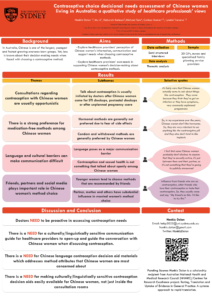 This poster was presented by Ms Hankiz Dolan at the 10th International Shared Decision Making Conference in Quebec, Canada, 7-10 July 2019. (PDF)
This poster was presented by Ms Hankiz Dolan at the 10th International Shared Decision Making Conference in Quebec, Canada, 7-10 July 2019. (PDF)
Dolan H, Li M, Bateson D, Tam M, Bonner C, Trevena L. Contraceptive choice decisional needs assessment of Chinese women living in Australia: a qualitative study of healthcare professionals’ views [poster]. 10th International Shared Decision Making Conference. Université Laval, Quebec City, Canada. 2019 July 7-10.
Abstract
Background
Decisions about contraceptive methods are preference sensitive and ideal for shared decision-making (SDM). Migrant and refugee women are vulnerable in terms of accessing evidence-based and culturally and linguistically sensitive contraception information and services. In Australia, Chinese is one of the largest, youngest and fastest growing overseas-born groups. Yet, less is known about their decision-making needs when faced with choosing a contraceptive method.
Aim
Explore healthcare providers’ perception on Chinese women’s information, communication and support needs when choosing contraceptive methods. It also aims to explore healthcare providers’ own in supporting Chinese women’s decision making about contraceptive methods.
Methods
We conducted semi-structured in-depth interviews with 20 healthcare providers, including general practitioners, specialised sexual and reproductive health doctors and nurses, who had substantial experience in providing contraceptive services to women from Chinese background. We adapted our interview guide from the Ottawa Decision Support Framework. We will take thematic analysis approach to analyse the interview transcripts.
Results
This study is ongoing, and results will be updated. Overall, healthcare providers highlighted the opportunistic nature of the consultations regarding contraception with Chinese patients. They observed a preference for contraceptive methods that do not involve hormones among Chinese patients due to fear of hormonal side effects. They noted language being the major barrier for effective communication and as well as cultural barriers where Chinese women can be reluctant to discuss contraception.
Conclusions
The study results highlight the need for improved, linguistically and culturally appropriate contraceptive method decision support strategies for Chinese women. Future interventions could benefit from providing orientation to Australian healthcare systems, including the role of general practitioners and specialised sexual and reproductive health services, to recent arrivals from Chinese background. Also, there is a need to for Chinese language contraceptive choice decision aid tools which addresses contraceptive method attributes that Chinese women concerned about and there is also a need for a culturally sensitive communication guide for healthcare providers to open-up and guide the conversation with Chinese women when discussing contraceptive methods.
